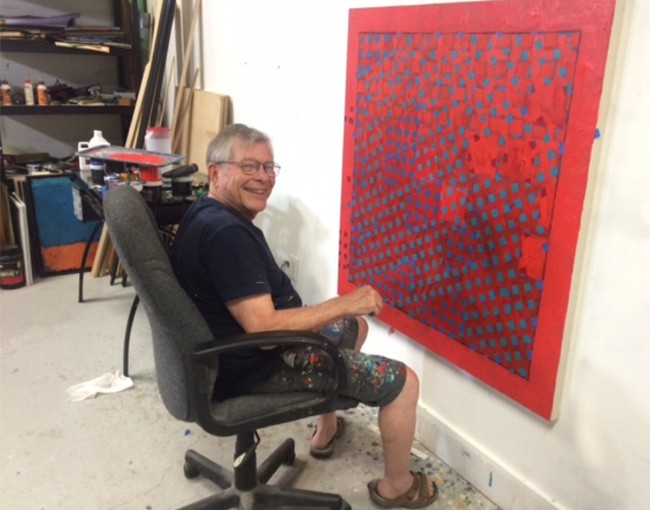 Courtesy of Five Deuces Galleria
Courtesy of Five Deuces Galleria
Story and photos BY PHIL LAVERY
NNB Student Reporter
ST. PETERSBURG – Drawn by low rent and abundant space, artists have flocked to the northern flank of Midtown in recent years. In once-empty warehouses, they are painting on canvas, sculpting in copper and blowing hot glass into objets d’art.
One of the converted warehouses is called Five Deuces Galleria, a three-building complex of studios and galleries at 222 22nd St. S that is a production center for art and aspirations.
Meet four of the artists who work there.
* * * * * * * *
 Melissa Harasz
Melissa Harasz
She comes from a family of artists and painters and has been painting since she was 9. Now 55, Harasz swims competitively and specializes in underwater scenes.
She pays a little more than $400 for an air-conditioned studio.
She says she likes the vibe of the Warehouse Arts District and its proximity to downtown.
“My process begins with a photograph. Once I study the photo, I’ll allow my imagination to take over.”
This oil-on-canvas painting of a man swimming underwater is typical of Harasz’s work.

This scene is one of her favorites.

* * * * * * * *
 Maureen McCarthy
Maureen McCarthy
Art was just a hobby for her until her divorce a year ago.
Now she restores furniture full time and paints with oil on canvas.
After looking all over town, McCarthy, 44, decided to rent a studio at Five Deuces.
“There were studios where the rent was cheaper, but they felt cold. I looked for three weeks and settled on this place. My studio has got a warm feeling to it, which is very conducive to my creative process.”
 McCarthy likes to paint landscapes, like this scene of a Florida sunset.
McCarthy likes to paint landscapes, like this scene of a Florida sunset.

This is an old living room table made new, an example of the small tile pieces that McCarthy likes to use in her restorations.
* * * * * * * *
 Sean Alton
Sean Alton
Alton, 55, works with copper and glass sculpturing. “We get a lot of foot traffic” at Five Deuces, he says. It “has a good draw, being in the Warehouse Arts District. It’s a pretty cool place.”
“I consider myself a surrealist sculptor, incorporating people with animals in a non-sexual way. I started working with metal as a jeweler. In 1995 I left that job and began experimenting with copper sculpting, eventually adding glass to my sculptures.”
In copper sculpting, a mass of copper is melted in a kiln, usually several times. Once the cooper is removed, Alton does the enameling, which is adding class to the surface. Here is a finished copper sculpture with enamel.

In this 2-foot-long piece, an alligator is eating a person alive.

* * * * * * * *
 Jim Corp
Jim Corp
He has been a woodworker, a fisherman, a real estate developer and a business owner. Now Corp, 68, is an artist who says his work is half digital, half oil-on-canvas.
“The process of creation between digital prints and hand paintings are different, as one requires a computer and the other is by hand. How I find my inspiration, however, is pretty much the same. Even working with digital prints, coming up with an idea and then manifesting that into something tangible, is exactly the same as painting by hand.”
This is one of Corp’s digital prints. Its abstract style is a theme in most of his digital work. The printer he uses is expensive and requires a special ink toner.

This hand painting has the look of Andy Warhol. Notice the Campbell’s Soup cans at the bottom.



 Rebekah Davila | NNB
Rebekah Davila | NNB Rebekah Davila | NNB
Rebekah Davila | NNB Rebekah Davila | NNB
Rebekah Davila | NNB Candice Reshef | NNB
Candice Reshef | NNB Rebekah Davila | NNB
Rebekah Davila | NNB Candice Reshef | NNB
Candice Reshef | NNB Zachary Gipson-Kendrick | NNB
Zachary Gipson-Kendrick | NNB Rebekah Davila | NNB
Rebekah Davila | NNB Zachary Gipson-Kendrick | NNB
Zachary Gipson-Kendrick | NNB Rebekah Davila | NNB
Rebekah Davila | NNB Candice Reshef | NNB
Candice Reshef | NNB Rebekah Davila | NNB
Rebekah Davila | NNB Rebekah Davila | NNB
Rebekah Davila | NNB Lauren Hensley | NNB
Lauren Hensley | NNB Lauren Hensley | NNB
Lauren Hensley | NNB Rebekah Davila | NNB
Rebekah Davila | NNB Rebekah Davila | NNB
Rebekah Davila | NNB
 Candice Reshef | NNB
Candice Reshef | NNB








